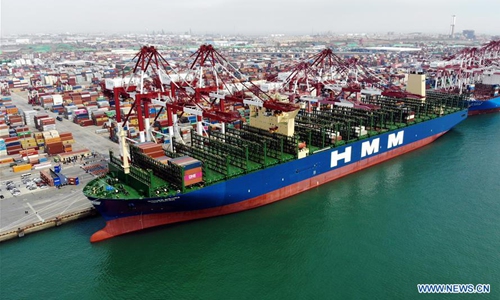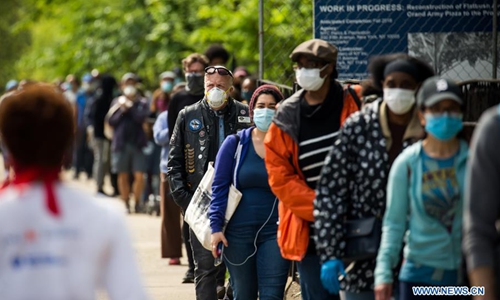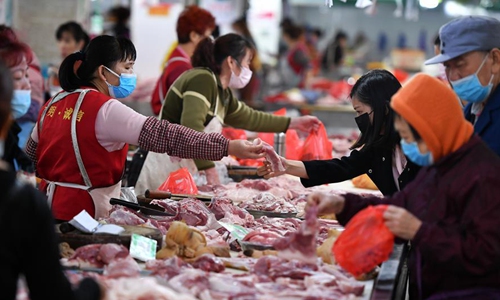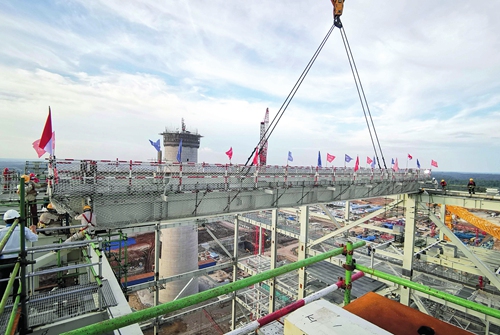Fresh tariff threat adds woes to US economy

Aerial photo taken on April 26, 2020 shows HMM Algeciras docking at Qingdao Port in Qingdao, east China's Shandong Province. HMM Algeciras, the largest container vessel on earth with a TEU (20-foot equivalent unit) capacity of 24,000, started its maiden voyage from the port of Qingdao on Sunday. (Xinhua/Li Ziheng)
While China, the world's second largest economy, has gradually returned to normal as the COVID-19 epidemic has subsided in the country and it has offered a helping hand to overseas markets by donating and exporting medical supplies to combat the pandemic, the Trump administration is wracking their brains seeking ways to redirect its own mismanagement of the coronavirus spread toward China as if things are not bad enough in the US.
Top Chinese and US trade negotiators will speak as soon as next week on progress in implementing the phase one trade deal after US President Donald Trump threatened to "terminate" the agreement if China wasn't adhering to the terms, Bloomberg reported Thursday.
Trump on May 1 threatened new tariffs on China and said his administration had crafted retaliatory measures over the COVID-19 outbreak.
On Wednesday, he said he would be able to report in about a week or two whether China is fulfilling its obligations under the phase one trade deal the two countries signed in January before the coronavirus spread globally, Reuters reported.
Faced up with mounting pressure to handle the COVID-19 pandemic as US confirmed cases of cononavirus have surged to over 1.2 million, with a death toll of more than 74,000, the highest in the world, as well as the shrinking chances of his reelection, Trump again used the threat of tariffs as his weapon.
But this time, the weapon is losing its magic as the pandemic has altered the situation the world's two largest countries were in during the past two years of the trade war, and China will retaliate if the tariff threats were implemented. New tariffs will only add woes to the already-damaged US economy, experts told the Global Times.

People wait in line to receive free face masks at the Prospect Park in the Brooklyn borough of New York, the United States, May 3, 2020. New York City (NYC) will be distributing over 100,000 face coverings in parks across the city free of charge from May 2 to 5. According to the guidance from the NYC Health Department, all New Yorkers are required to wear a mask or face covering in public and in situations where a 6-foot distance from others cannot be maintained. (Photo: Xinhua)
China has shown its sincerity and played its part in the phase one trade pact, and has kept an open mind toward a phase two deal. But the US has continued to worsen the political environment for China to do that. Everyone knows implementing an agreement has to be achieved through efforts from both sides, experts said.
Deal progressing
Despite China keeping a low-profile on the progress of the phase one trade deal, the country has been implementing the hard-won agreement even amid the pandemic impact, Song Guoyou, deputy director of the Center for American Studies at Fudan University, told the Global Times Thursday.
"It's also not necessary to say everything you've done," Song said.
Chinese companies bought more than 1.1 million tons of US soybeans between mid-March and late-April, according to Zhang Xiaoping, country director for China at the Missouri-based US Soybean Export Council. The figure shows China's efforts to carry out the deal, as China usually buys soybeans from Brazil and other South American suppliers starting March.

Residents buy meat at a market in Haikou, south China's Hainan Province, Jan. 31, 2020. Supply of daily necessities remained steady in major Chinese cities while authorities have been stepping up efforts to ensure continuous supply and stable prices amid the novel coronavirus outbreak. (Xinhua/Guo Cheng)
As the COVID-19 pandemic continues to batter US economic activities, more slaughterhouses have been forced to shut down due to the virus infections, risking the US meat supply.
The situation could lower China's meat imports from the US, according to Gao Lingyun, an expert at the Chinese Academy of Social Sciences, who advises the central government on trade policies.
China, the world's top pork consumer, bought $5.05 billion in farm goods from the US in the first quarter of 2020, up 110 percent from last year, including 168,000 tons of US pork, a more than sevenfold increase, Chinese customs data showed in April.
Latest data from China's General Administration of Customs showed on Thursday that China's imports from the US in April amounted to 64.65 billion yuan ($9.11 billion), a slight decline from March's 69.07 billion yuan. Exports in April rose to 225.34 billion yuan, up 28 percent month-on-month.
"The imports reduction was mainly related with poultry according to real-time monitoring, while exports increased thanks to the surging demand in the US for medical supplies," Gao said.
April is simply "too early" for the US to say that China has not implemented the trade pact.
"The phase one agreement also stipulates that the US needs to provide China with a good and convenient execution condition," Song noted, "However, during the epidemic, the US has failed to fully fulfill its obligations."
If the situation continues to worsen, "more uncertainties on the implementation of the deal may emerge," he noted.
The phase one deal involved a commitment from China to increase its imports of US agricultural products, energy, manufactured goods and services by $200 billion over a span of two years. In exchange, the US halved tariffs on $120 billion in imports from China and canceled tariffs on another $160 billion, even though it retained increased duties on partial Chinese imports.
As far as Gao is concerned, Trump's new threat might indicate that he wants to push the phase two deal with China for more leverage, which will focus on some controversial issues that were left from the first pact, including subsides and China's state-owned enterprises.
"Even if the new tariffs become real, regardless of the approach, it will only add woes to the US economic downturn," said Gao.
The US economy contracted 4.8 percent in the first quarter of 2020, while GDP growth is likely to dive by double digits in the second and third quarters as the number of people applying for unemployment benefits has soared to decades high.
The Institute for Supply Management (ISM) Purchasing Managers' Index for the US last month fell to 41.5 from 49.1 in March, its lowest figure since April 2009.
In terms of China's preparations, Gao said the country has harnessed a mature and quick-response system of countermeasures against the US tariffs based on experiences in the past two years.
"From the initial concerns, to finding out the impact of the trade war, then to shifting to the current mind-set of calm and frankness, China has grown," Gao said.
Unexpected growth
Time is on China's side. Multinational firms will vote with their feet during and after the epidemic since they would start considering the situation: Who is the first to rebound? The US call to its firms to relocate their supply chain from China would prove fruitless.
Thursday's customs data showed that China's yuan-denominated exports increased 8.2 percent year-on-year to 1.41 trillion yuan in April, beating market expectations of double-digit negative growth. Imports were recorded at 1.09 trillion yuan, down 10.2 percent on a yearly basis.

The Bukit Asam Coal Power Plant of Indonesia is under construction on Sunday. The China-Indonesia joint project is a part of the two countries' cooperation on the Belt and Road Initiative. Photos: cnsphoto
Economists polled by Reuters had expected exports from China to fall 15.7 percent in April from a year ago, and imports were projected to shrink 11.2 percent over the same period. That would have been the sharpest drop since July 2016.
In March, the plunge in China's imports and exports had eased from the January-February period as exporters rushed to clear a backlog of orders which could not be shipped on time due to production shutdowns.
In the first two months of 2020, China's exports contracted 17.2 percent year-on-year and imports fell 4 percent as the novel coronavirus outbreak battered the country's economic activities.
Liu Xuezhi, a senior economist at the Bank of Communications, told the Global Times Thursday that the unexpected growth in exports is mainly due to a continuous clearing of orders. Additionally, China's exports of medical supplies to aid other countries and regions combat the COVID-19 pandemic are also surging.
In the January-April period, China exported textile products including masks worth 261.3 billion yuan, up 5.9 percent year-on-year, according to customs data.
The jump in China's April exports data was unexpected, indicating that overseas demand for China's products remains strong despite the COVID-19 impact, while a slump in imports shows domestic demand has yet to recover and needs further stimulus, said Wang Jun, chief economist at Zhongyuan Bank.
ASEAN and countries and regions along the routes of the Belt and Road Initiative, which have maintained a sound and stable trade with China amid the pandemic, will help stabilize China's foreign trade even when the US market withers, said Wang, noting that China's regional partners will play a more significant role in the post-pandemic period. Exports to ASEAN, China's largest trading partner, rose 3.9 percent year-on-year in the first four months of the year, while imports from the Asian economic bloc increased by 8 percent on a yearly basis.